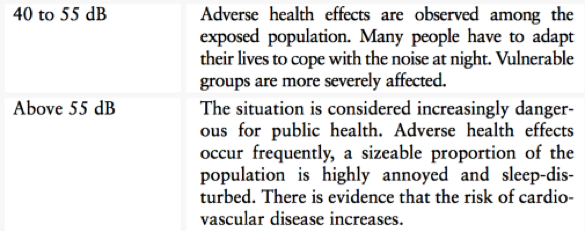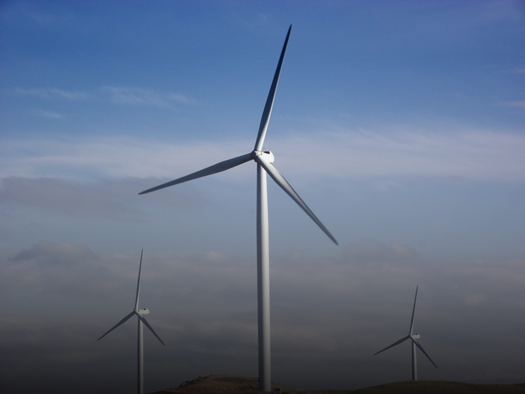Two issues surround whether industrial wind is the healthy alternative energy source some claim it to be. Both issues involve noise created from the constant turning of industrial blades: there is an obvious audible sound and a more subtle infrasound.
These sound issues, audible sound and infrasound, are known to cause sleep disturbances and other health issues.
Renewable Northwest, a renewable energy non-profit organization, says the average wind turbine operates at around 50 decibels–but it’s much worse at night. According to a 2003 study, nighttime sound levels could be up to 18 decibels higher than the predicted daytime levels. This is especially true for tall wind turbines, 300 feet high or taller.
The World Health Organization recognized in a 2009 study that 40-55 decibels during sleep cycles can cause “Adverse health effects…” and that “vulnerable groups”, such as children, the chronically ill and the elderly, “are more severely affected”. Sound levels above 55 decibels can also cause an increase the risk of cardiovascular disease.

(Figure 1: The WHO 2009 Night Noise Guidelines)
That means that at night, the average wind turbine could be producing up to 68 decibels of sound, 10 decibels over the amount WHO recognizes as a danger to public health.
The second danger is much more subtle, infrasound.
Infrasound is frequencies that range from 20 hertz or lower. While this frequency is considered inaudible in humans, the oscillating nature of the wind turbine’s blades can stimulate the ear so that it “feels” the vibrations.
The International Organization for Standardization, an independent, non-governmental international organization and the world’s largest developer and publisher of International Standards, says that vibrations between 1hz and .1 hz can cause motion sickness as cited in ISO 9996:2000.
For industrial wind farms, the amounts of infrasound and level of vibrations are directly related to the size of the wind turbine. Robert Rand, a boulder-based sound consultant, found in his preliminary field report the correlating relationship between an increase in low frequency noise production and the size of the wind turbines.
In 2011, Henrik Møller and Christian Pedersen, researchers in Denmark, also found the same relationship, “…as turbines increase in size, the relative amount of low frequency noise is greater.”

(Figure 2. X-axis shows size of turbine and Y-axis shows frequency. This graph shows a correlation between the size of the turbine and what frequency it produces.)
Long-term exposure to infrasound can lead to sleep deprivation, stress, and even heart palpitations. And according to two different studies, the larger the wind turbines the higher the probability of adverse health impacts.
While the evidence is stacking up against industrial wind farms, there are two main solutions.
The first is distance. Both the British Noise Association and the French Academy of Medicine recommend a minimum of 1.5 km, or 1 mile, distance for wind farms to be next to residential areas.
The second option is for wind farms to become smaller, both in height and site density. Densely packed industrial wind farms compound the problems of infrasound and audible sound. Spreading wind farms out, or placing fewer in an area, could decrease the negative effects of sound.
The Golden-West wind farm in Calhan, Colorado is in need of these solutions. The minimum distance from non-participating houses, residents that did not allow turbines to be built closer than the legal distance, is only 1320 feet. That is only a quarter mile, which is significantly less than the distance recommended by both the British Noise Association and the French Academy of Medicine.
Not only are the Golden-West turbines close to the residences of Calhan, they are also quite large. As seen in figure 2, the Vestas V17, which is used in Denmark, is only 72 feet tall. The turbines used at the Golden-West wind farm are up to 315 feet tall. At that size, the Golden-West wind farm would be producing low enough frequencies to cause motion sickness as described in ISO 9996:2000.
By decreasing the height and the blade size of wind turbines or increasing distance from rural/residential areas, wind farms can help fight the effects of audible sound and infrasound.
Kohl Watson is a Future Leaders intern for the Energy Policy Center at the Independence Institute. Kohl previously served in the United States Army.








